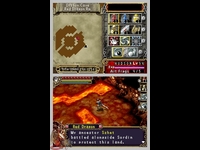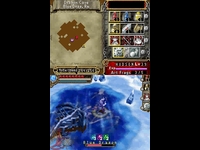|
In order to clear up some confusion, there are two distinct games being released under the name Dungeon Explorer: Warriors of Ancient Arts. Unlike original expectations, the Sony PSP and Nintendo DS versions are not the same game. The PSP version is a hack-and-slash RPG designed more with local multiplayer in mind, while the Nintendo DS version is a slower-paced action RPG with the player spending most of the time playing alone. In order to complete the game, it's highly recommended to find other players with the Nintendo Wi-Fi, which is the only multi-player interaction the game offers. This review is specifically pertaining to the Nintendo DS title.
The Nintendo DS has been a continued source of innovative gameplay through use of the dual screens and the stylus controls. Very many games take advantage of both of these features, but Dungeon Explorer is not one of them. When playing Dungeon Explorer, players can leave the stylus in the storage slot as it is not needed. This was disappointing from the start because gamers have become used to playing with a combination of stylus and buttons, if not stylus alone. Reverting to button-only play scheme with a Nintendo DS is an alienating experience.
This is not the only example of the game's awkwardness. The graphics look very dated for today's handheld market. While Dungeon Explorer does use both screens, the secondary screen is used almost exclusively for a map. The game allows either screen to be set as the map, which is nice, but also gives it the feeling that there really is only one screen used, and a secondary map function tossed into the game because there was nothing better to do with it. On the contrary, a lot of touch screen usage could have been implemented that would have improved the game.
 Around and around
Around and around
|
|
The story is very basic. It starts with an awkward cut-scene with goblins telling a tale around a fire, trying to spook younger goblins late at night. Through various grunts and groans, the image is given that the tale about to take place happened a long time ago. The tale begins with the player trying to make his or her way as an adventurer by attempting to save a town from certain doom. This hero is somewhat customizable in regards to race and class. Typically, the desired class will decide the race the hero ends up, because the class is the limiting factor. Race then will decide the gender. The hero is told about the great evil trying to escape from a large structure right in the middle of town. Someone or something is weakening the barrier holding the evil inside, and it is up to the new adventurers to find out what it is. Even though there is talk that our hero is just one of many, don't expect to run into anyone else who might be doing the same thing. Yet, at the end, people are expected to band together to find and defeat the great evil. It's a rather perplexing plan to save the world. It seems odd that people are placing their faith in a team of people that have never worked together, but must have been simpler times.
The only companion through most of the game is a robot, purchasable in town for a substantial cost. The only way outside of town to heal the robot is to feed it equipment the hero does not want. There are no other items or repairing options available. On the plus side, a piece of equipment takes just as much storage space on the character as a small potion. Stocking up on some cheap armor for the robot is no more an issue than stocking up on healing potions for the hero--except the cost. If the robot breaks down completely from enemy attacks while on the adventure, it is considered destroyed and lost. The robot never really shines as a useful companion and seems to be targeted more than the hero. It is not a good resource unless the hero is drowning in cash.
The battle system is not as straight forward as it originally seems. The very first quest sends the player off to find a school to train under. Oddly enough, the school is actually in a forest outside of town. Once the hero navigates the tiny maze and finds the runes for the school, the hero is randomly assigned a school with little more thought than that of a spin of a roulette wheel. From this school, the hero gains two abilities instantly. Using these two abilities opens up skills, or Arts, that use up its own blue bar. It is very rare for the hero to run low on Art power. Other than this, our hero relies on weapons. Each weapon has a charge ability built in. When the weapon is used, it begins to charge. It will strike harder the greater charge it has. A full charge typically takes only a few seconds, but with no rest from the wicked, longer battles typically revert to a game of tag. The hero will attack the enemy, move about the room until the charge is full, then attack the enemy again. The enemies seem to be a step slower to allow this tactic to be successful. However, it is not very riveting gameplay. The Arts provide a little variation, but the bosses hit so hard that exploration of what may or may not work could be more risky than returning to the game of tag.
 Blue vs. Blue
Blue vs. Blue
|
|
Healing is really where the game mechanics break down and where stylus use could have fixed a lot of issues. The buttons X and Y allow for assigning of items that can be used with a single button press. Each of these buttons can be assigned three items each from the main menu where the game is paused. During the course of battle, the hero can swap these with what should be an easy system: hold down the shoulder button and move the yellow boxes to the correct item. The only problem is the action doesn't stop even though the hero stops moving. Swapping items in this fashion is best done after running away from combat, or just hoping that the hero can kill the monsters before the item is truly needed. The common items are healing potions, status recovery, and offensive stones used to easily destroy monster generators. Three highly used items that must be shared between only two buttons. An item system where the stylus could have been used to select an item quickly would alleviate this issue. Instead, a cumbersome system forces the player to decide which two items are most important before engaging in combat. An error in that decision will force the player to either run away or die trying.
The music and sounds also strengthen the impression that this game was simply not designed to make the best of the hardware. Like the grunts from the goblins, the hero is greeted with a short sound from each NPC every time they engage in discussion. There are no voices or anything that really gives the dialog any form of like. The music itself is completely forgettable--if noticed in the first place. With musical scores on handhelds improving all the time, this is appalling from a player's standpoint.
Dungeon Explorer: Warriors of Ancient Arts for the Nintendo DS fails to meet even the basic of expectations from the over-populated dungeon crawling sub-genre. There is nothing that makes this title stand out from any other out there, except its age and the fact that it is challenging due to some tricky mechanics within the game. It is difficult to recommend this game to even the hardcore crawler fans, because there is no real challenge once the tag game is mastered. Maybe it would have survived the Game Boy Advance age, but now it's simply too little, too late for today's market.
Review Archives
|









